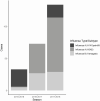Vaccine Effectiveness Against Acute Respiratory Illness Hospitalizations for Influenza-Associated Pneumonia During the 2015-2016 to 2017-2018 Seasons: US Hospitalized Adult Influenza Vaccine Effectiveness Network (HAIVEN)
- PMID: 34320171
- PMCID: PMC9049268
- DOI: 10.1093/cid/ciab654
Vaccine Effectiveness Against Acute Respiratory Illness Hospitalizations for Influenza-Associated Pneumonia During the 2015-2016 to 2017-2018 Seasons: US Hospitalized Adult Influenza Vaccine Effectiveness Network (HAIVEN)
Abstract
Background: Evidence for vaccine effectiveness (VE) against influenza-associated pneumonia has varied by season, location, and strain. We estimate VE against hospitalization for radiographically identified influenza-associated pneumonia during 2015-2016 to 2017-2018 seasons in the US Hospitalized Adult Influenza Vaccine Effectiveness Network (HAIVEN).
Methods: Among adults aged ≥18 years admitted to 10 US hospitals for acute respiratory illness (ARI), clinician-investigators used keywords from reports of chest imaging performed during 3 days around hospital admission to assign a diagnosis of "definite/probable pneumonia." We used a test-negative design to estimate VE against hospitalization for radiographically identified laboratory-confirmed influenza-associated pneumonia, comparing reverse transcriptase-polymerase chain reaction-confirmed influenza cases with test-negative subjects. Influenza vaccination status was documented in immunization records or self-reported, including date and location. Multivariable logistic regression models were used to adjust for age, site, season, calendar-time, and other factors.
Results: Of 4843 adults hospitalized with ARI included in the primary analysis, 266 (5.5%) had "definite/probable pneumonia" and confirmed influenza. Adjusted VE against hospitalization for any radiographically confirmed influenza-associated pneumonia was 38% (95% confidence interval [CI], 17-53%); by type/subtype, it was 74% (95% CI, 52-87%) influenza A (H1N1)pdm09, 25% (95% CI, -15% to 50%) A (H3N2), and 23% (95% CI, -32% to 54%) influenza B. Adjusted VE against intensive care for any influenza was 57% (95% CI, 19-77%).
Conclusions: Influenza vaccination was modestly effective among adults in preventing hospitalizations and the need for intensive care associated with influenza pneumonia. VE was significantly higher against A (H1N1)pdm09 and was low against A (H3N2) and B.
Keywords: case-control study; hospitalization; influenza vaccine effectiveness; pneumonia; test-negative.
© The Author(s) 2021. Published by Oxford University Press for the Infectious Diseases Society of America. All rights reserved. For permissions, e-mail: journals.permissions@oup.com.
Figures


Similar articles
-
Influenza vaccine effectiveness against influenza-related hospitalization during a season with mixed outbreaks of four influenza viruses: a test-negative case-control study in adults in Canada.BMC Infect Dis. 2017 Dec 29;17(1):805. doi: 10.1186/s12879-017-2905-8. BMC Infect Dis. 2017. PMID: 29284435 Free PMC article.
-
Seasonal influenza vaccine effectiveness against laboratory-confirmed influenza hospitalizations - Latin America, 2013.Vaccine. 2018 Jun 7;36(24):3555-3566. doi: 10.1016/j.vaccine.2017.06.036. Epub 2017 Jun 23. Vaccine. 2018. PMID: 28648543 Free PMC article.
-
Vaccine effectiveness against influenza hospitalisation in adults during the 2022/2023 mixed season of influenza A(H1N1)pdm09, A(H3N2) and B circulation, Europe: VEBIS SARI VE hospital network.Influenza Other Respir Viruses. 2024 Feb;18(2):e13255. doi: 10.1111/irv.13255. Influenza Other Respir Viruses. 2024. PMID: 38403302 Free PMC article.
-
Low Influenza Vaccine Effectiveness Against A(H3N2)-Associated Hospitalizations in 2016-2017 and 2017-2018 of the Hospitalized Adult Influenza Vaccine Effectiveness Network (HAIVEN).J Infect Dis. 2021 Jun 15;223(12):2062-2071. doi: 10.1093/infdis/jiaa685. J Infect Dis. 2021. PMID: 33140094 Free PMC article.
-
Influenza vaccine effectiveness against hospitalization with laboratory-confirmed influenza in Greece: A pooled analysis across six seasons, 2013-2014 to 2018-2019.Vaccine. 2020 Mar 10;38(12):2715-2724. doi: 10.1016/j.vaccine.2020.01.083. Epub 2020 Feb 6. Vaccine. 2020. PMID: 32033848
Cited by
-
Prevalence and Clinical Outcomes of Respiratory Syncytial Virus vs Influenza in Adults Hospitalized With Acute Respiratory Illness From a Prospective Multicenter Study.Clin Infect Dis. 2023 Jun 8;76(11):1980-1988. doi: 10.1093/cid/ciad031. Clin Infect Dis. 2023. PMID: 36694363 Free PMC article.
-
Influenza Vaccine Effectiveness against Hospitalization, Season 2021/22: A Test-Negative Design Study in Barcelona.Vaccines (Basel). 2023 Sep 2;11(9):1450. doi: 10.3390/vaccines11091450. Vaccines (Basel). 2023. PMID: 37766127 Free PMC article.
References
-
- Shah NS, Greenberg JA, McNulty MC, et al. . Severe influenza in 33 US hospitals, 2013-2014: complications and risk factors for death in 507 patients. Infect Control Hosp Epidemiol 2015; 36:1251–60. - PubMed
Publication types
MeSH terms
Substances
Grants and funding
LinkOut - more resources
Full Text Sources
Medical

